One year ago, state media largely ignored the biggest outbreak of civil unrest in Kazakhstan’s history. The job of informing the public objectively about the widespread protests fell on independent reporters and a few so-called citizen journalists and bloggers who did their jobs at great personal risk. These journalists were attacked by protestors, assailed and tear-gassed by police, shot with rubber bullets, detained, and in some cases arrested, beaten, and imprisoned.
When the air, so recently filled with smoke from grenades and bullets, both rubber and real, cleared, reporters were the ones pressing the government for a full accounting of the 238 people killed, more than 4,500 injured, around 10,000 detained, and several hundred reportedly tortured.
This is the story of the Qandy Qantar — “Bloody January” — uprising through the eyes of those who covered it, beginning in Zhanaozen and ending in Almaty.
You can read this series in English at The Diplomat and in Russian and Kazakh at Orda.kz.
AKTOBE, Kazakhstan: Azattyq reporter Zhanagul Zhursin braced against the cold wind near the regional mayor’s office and watched as about a hundred delivery drivers grumbled about gas prices.
Zhanagul, wearing her blue press vest with silver stripes, had covered many protests in her 26 years as a reporter. She initially didn’t think there was anything ominous about this particular one on January 3. There didn’t even seem to be a leader, and at that point, the police hadn’t detained anyone on the square. Both the deputy regional mayor and the city mayor showed up and urged the small crowd to stay calm. After a couple of hours, people left.
By the next day, the predominately male crowd had swelled to several thousand, steel workers joining the delivery drivers and others. “Every hour there were more people,” Zhanagul remembered.
Police blocked roads leading to the regional mayor’s office, but protesters skirted the barricades and set up a yurt in the city square. Ratel.kz reporter Dmytry Matveyev said some of the protesters were drunk. Many were chanting anti-government slogans. Police filmed the demonstrations in order to identify and later arrest people, he said.
With a population of nearly half a million, Aktobe is the fourth largest city in Kazakhstan. It is also where one of the country’s first terrorist attacks took place in 2011 when an extremist blew himself up at the local National Security Committee (KNB) office. Five years later, 25 people were killed during shootouts between police and gunmen suspected of being Islamists.
“After that, Muslims were the fall guys. They were like monsters,” Dmytry explained. “The government didn’t allow these fundamentalist religious groups to gather because they were always afraid it would spiral out of control. But at the January protest, there were lots of people with beards and the police didn’t react at all.”
In Central Asia, men who wear beards are often viewed as fundamentalist Muslims.
Dmytry and Zhanagul both said authorities asked them not to report what was happening. Both refused.
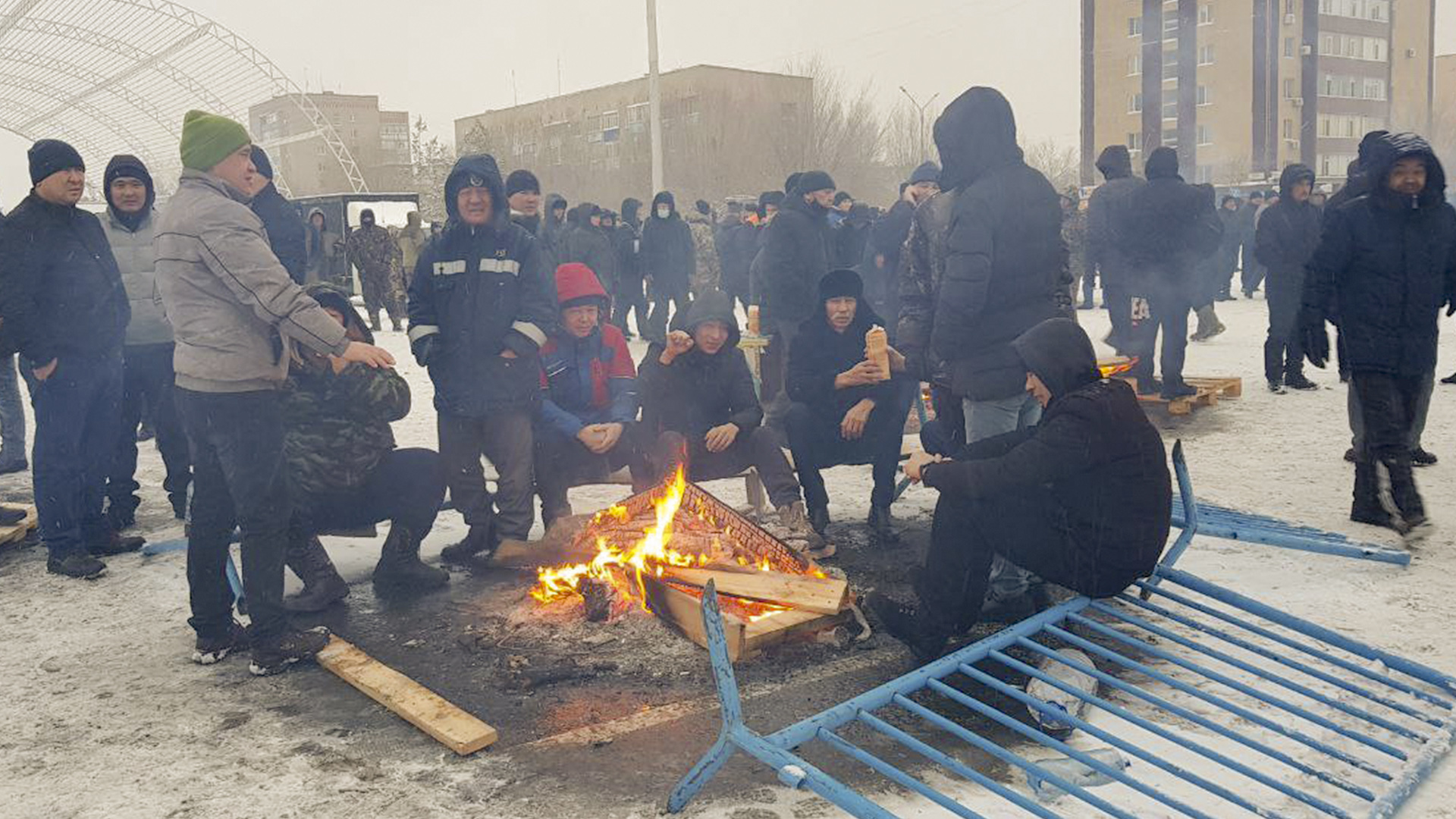
Men attending the protest in Aktobe in early January 2022 warm themselves by a fire. Photo credit: Yuri Geist.
Atyrau
Meanwhile, 380 miles away in Atyrau, a city of about 355,000, more than 5,000 protesters had gathered on the square on January 4.
Aynur Saparova and Farhat Abilov, reporters with Ak Zhaiyk, filmed the crowds as they demanded authorities lower the prices for food and fuel. The regional mayor tried to assuage the crowd but few could hear him over the shouting. Someone even suggested they kidnap the mayor and ransom him to get their demands met, Aynur said.
By the next day, the crowd had become angry and impossible to control. Aynur remembered hearing a glass door breaking and an alarm shrieking at the regional mayor’s headquarters building. Police, who clashed with protestors, set off tear gas, which Aynur said irritated her eyes and her throat.
Farhat was filming rioters invading the mayor’s office, when a group of bearded men grabbed at his phone. They swore at him, hit him, and threatened to break his phone. “They thought I was working for the police,” he said.
Farhat and Aynur heard gunshots and saw the body of 35-year-old Almaz Berekenov on the ground behind the mayor’s office. “It was scary,” Aynur said. Later Aynur interviewed paramedics who told her six other protesters were shot; Berekenov was the lone fatality.
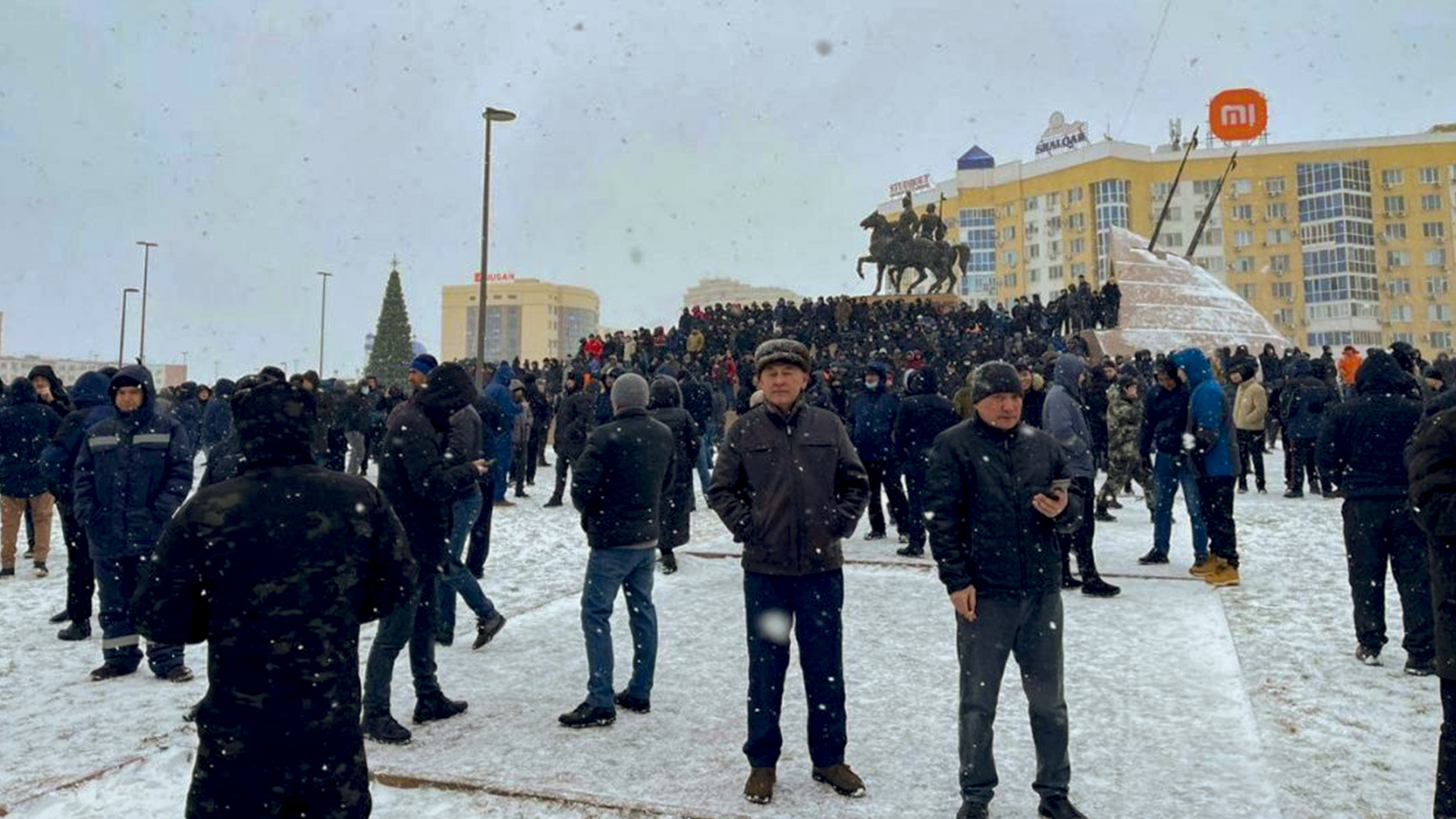
Protesters gathered in Atyrau near the statues of Makhambet and Isatay, two Kazakh heroes revered for leading a rebellion in 1836-37. Photo credit: Farhat Abilov.
In Aktobe, the Mood Turns
On January 5 the protest in Aktobe also turned ugly. Protesters broke down the door to the mayor’s building and tried to enter the building. Police fired rubber bullets and set off smoke grenades and tear gas.
Zhanagul saw protesters coughing, gasping for air, tears rolling down their cheeks. Some grabbed snow off the ground and ate it to try to soothe the burning sensation in their mouths.
A video posted by one of Zhanagul’s colleagues shows a man with a bloody head being carried by several others through a thick fog of tear gas. Faizulla Nurgeldin, 46, would die of complications from a head wound two months later.
Zhanagul’s 12-year-old daughter, who watched videos of the protest on social media, begged her mother to stay home. At night, her daughter slept with Zhanagul, holding her neck.
“Please don’t go,” she recalled her daughter saying. “I’ll wash the dishes myself for a whole month. I’ll take care of the cat.”
Zhanagul tried to explain to her daughter that it was her duty as a journalist. “I must be the one showing what is happening because there aren’t enough independent journalists.”
Her daughter urged her to let others do the risky work. “She was afraid I would be shot and die.”
Zhanagul began her career at a regional state television station, which was a far less risky job because state media outlets typically don’t cover protests. In 2011, Zhanagul joined Azattyq, U.S. supported Radio Free Liberty/Radio Europe’s Kazakh-language service.
Since then, Zhanagul said there have been several instances when tall men with black umbrellas have prevented her from filming protests. Once her apartment was broken into and a camera stolen. She said someone went through her computers.
Afterward Zhanagul’s husband, who works in a government tax office, urged her to quit Azattyq and to find a safer job with state media. Her husband, she said, is pro-Russian in regard to the war in Ukraine, while she sees Russian President Vladimir Putin as an aggressor.
“We are trying to find common ground, but I don’t know how long this will last. I’m trying to protect my daughter from propaganda.”

Fires burn in Aktobe as night falls and the character of the protests shifts. Photo credit: Yuri Geist.
Shooting Again
At 4:30 a.m. on January 7, Zhanagul was awakened by a phone call from a woman whose apartment windows overlook the square in Aktobe. “They are shooting,” the woman told her. “People are being pushed into paddy wagons. Even women are getting arrested.”
Zhanagul, who lives in a village outside of town, waited until sunrise to leave her house. It was raining hard, and when she arrived at the square, she found the place empty.
“It looked like after a war because there was still fire burning,” she said. “There were bullets left on the snow along with smoke bomb canisters and small balls from rubber bullets. The mayor’s office windows were broken. And all around the square were armed people blocking the entrances.”
Zhanagul soon learned that authorities had started “a special operation” and for the third time in days fired rubber bullets and gas at protesters in the early morning. As the crowd scattered, Ruslanbek Zhubanazarov, was killed as he was running away.
Her reporting would conclude that he died from a bullet to his heart, fired by the authorities, despite police testimony that they had only fired rubber bullets. In trying to get away, a motorist accidently hit a man who turned out to be a police officer.
In Aktobe, officials reported that 62 people were hospitalized with various injuries, including a dozen law enforcement officers. Authorities at the time bragged that the “rallies ended without bloodshed,” but concealed the death of Zhubanazarov, whose body was not returned to his family until a month later. About a thousand people were taken into police custody and questioned.
In Atyrau, about 60 people sought medical help at the hospital. Officials reported that 49 police officers and 28 National Guard members were injured. And although police denied they fired bullets , one man was shot in the head. Nearly 748 people were taken into custody for their participation in the protests in Atyrau.
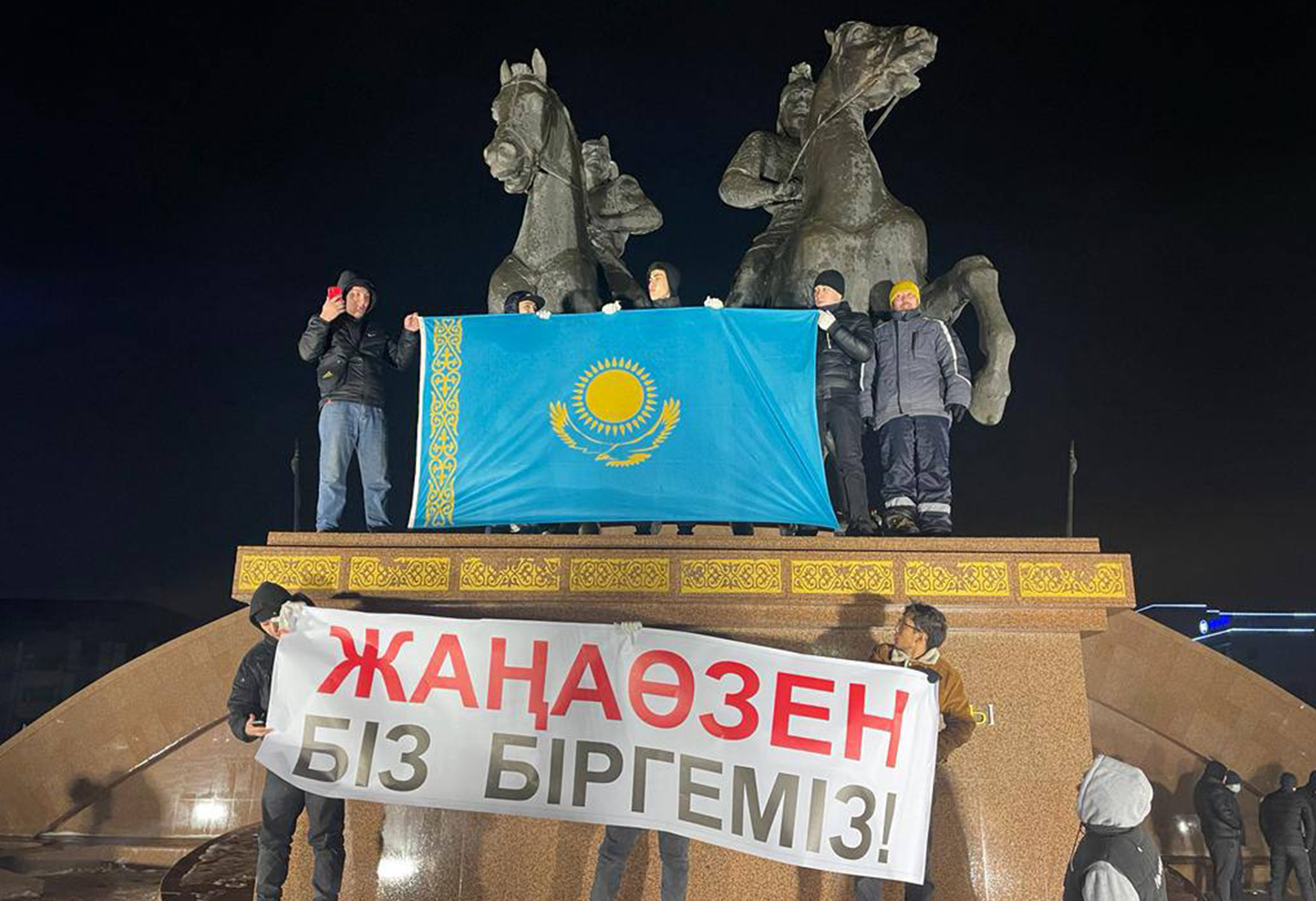
Protesters in Atyrau expressing solidarity with Zhanaozen. Photo credit: Farhat Abilov.
Police Round Up Reporters
Two days after the protests, police and KNB officers began rounding up journalists in Aktobe and Atyrau.
Around 11 p.m. on January 9, police arrived at the Aktobe house of Orda.kz journalist Ardak Erubayeva as she and her 13-year-old son were getting ready for bed.
Ardak said she was shocked when “I opened the door and there were five policemen” who brushed past her and began searching her apartment without presenting a warrant.
“I asked them what are you looking for? I told them I was a journalist and I showed them my press vest and documents.”
The men searched through her clothes, took her cell phone, and ordered her to come with them to the police station. Ardak asked if she could come in the morning.
“I told them I have my son here all alone. I don’t want to leave him.”
They told her to call someone to stay with him. “My son was scared. He was crying. Nothing had happened like this before.”
At the police station, Ardak was questioned for two hours; police released her at 3 a.m. They didn’t return her phone for 20 days, she said. Police subsequently questioned her two more times in the following weeks.
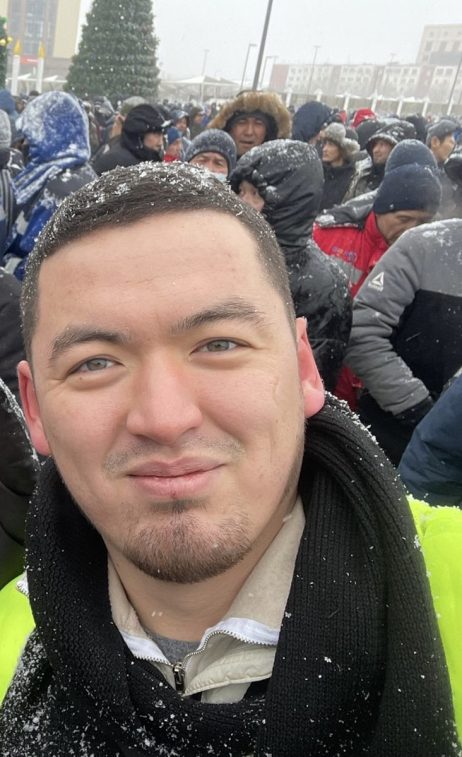
Farhat Abilov at the protest in Atyrau. Photo courtesy of Farhat Abilov.
On January 11, Atyrau reporters Aynur and Farhat at Ak Zhaiyk were called by police and asked to come to the station for questioning. Both demanded a court order. They received official documents the next day and complied.
When Farhat arrived, he noticed the police station was packed with young people. A police officer demanded Farhat give him the photos he had taken on the square. Farhat told him he could only see the photos with a court order. Police didn’t have such a document, so they released Farhat but warned they would call him back, he said.
Farhat wasn’t waiting. On January 13, he flew to Georgia where he stayed for a month. He spent his time looking for opportunities to go to the United States. When he returned to Kazakhstan, he quit his job at Ak Zhaiyk and began to freelance.
“I was tired of the lack of democracy, lack of freedom of speech, the low salaries but high prices,” he said. “Life is very hard here.”
Aynur was stunned when she learned Farhat had fled the country. She said he had always had good relations with police officers. She also received an official summons and reported to the police station where she was questioned for three hours about why she was at the protest and why she took pictures.
“The officer was either very young or stupid, or pretended to be,” Aynur said. “She acted like she didn’t understand what a journalist was. I felt like I wasted three hours of my life.”
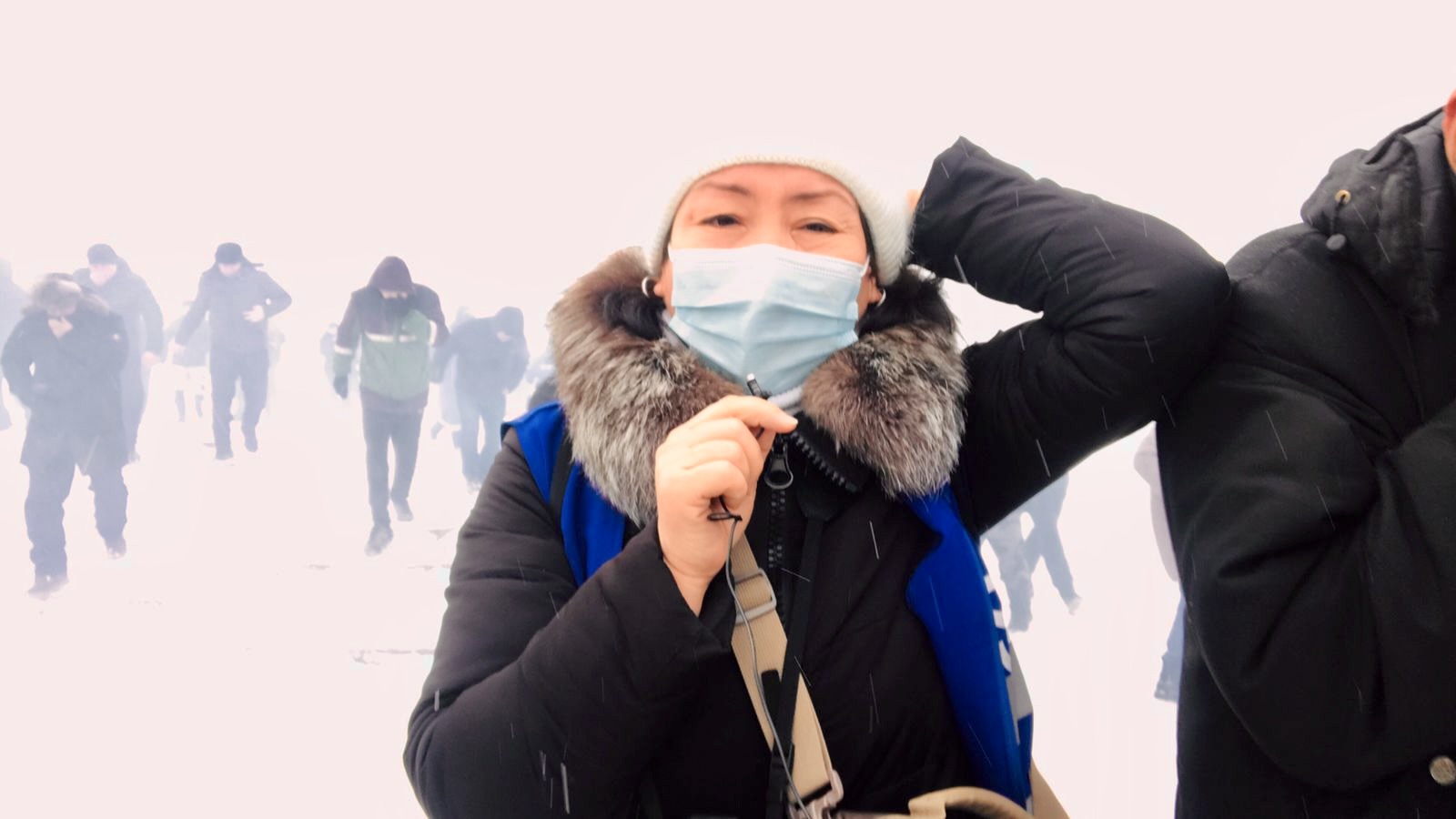
Zhanagul Zhursin at the protest in Aktobe. Photo courtesy of Zhanagul Zhursin.
On January 12, police in Aktobe summoned Zhanagul, Dmytry and a blogger named Aktamak Kopteuova to police stations where they were questioned for hours.
Police told Dmytry they wanted to charge him as a protester since he hadn’t worn his press jacket after the first day. Dmytry said he stopped wearing the vest after protesters became aggressive toward him.
He showed the police articles he had written on the Ratel.kz website. Dmytry said he was detained because his name was on a list of journalists who were writing critical articles.
“Those journalists who were loyal to the government and wrote that things were normal and calm, they were not taken into the police station,” Dmtry said.
His editors wrote letters to the mayor and to the police arguing that Dmytry was acting as a journalist, and they threatened to raise “a big noise” if he was put in prison, he said.
During his interrogation, police argued that Dmytry had written a lot of critical articles and it was time for the police to get their revenge.
“If you put me in prison, I will go on a hunger strike and it will cost you a lot,” he threatened.
Dmytry reflected that he had nothing to lose. “It was 15 days, not 15 years. I’m a criminal, judicial and corruption reporter. I understand the psychology of these people. I had to show I was not afraid and that they couldn’t break me.”
Police made jokes about Dmytry’s Jewish family. Officers also ridiculed him for being gay. He said police threatened to throw him in prison with hardened criminals where they intimated he would be raped.

Dmytry Matveyev months after the protests. Photo credit: Cheryl L. Reed.
“As soon as I’m in prison, I will get a lot of material about how police are torturing people, and I will write everything I know,” he told them. While he portrayed confidence, his back was wet with sweat during the interview. “I didn’t know what their next step was.”
Eventually the police released him. But several days later, he was called back to the police station. Investigators claimed they’d lost his interrogation documents. They needed him to come back in and sign some papers.
This time Dmytry returned with his lawyer. The document they presented him with called him “a witness for prosecution,” which meant he could be a criminal suspect. Dmytry refused to sign until the police changed the statement to list him as a simple witness.
Aktobe police deny that officers threatened or mistreated Dmytry.
“It never gets easier to work in independent media in Kazakhstan,” Dmytry said.
***
Tomorrow, January 4, we will follow the story of Kazakhstan’s Bloody January to Uralsk to Kyzylorda.
Kazakhstan’s Bloody January: Day 2, Aktobe to Atyrau
Source: Frappler

0 Comments